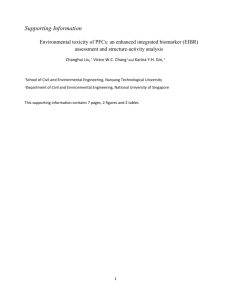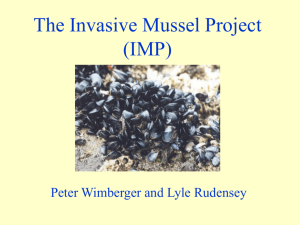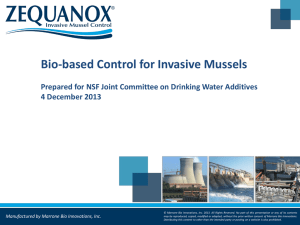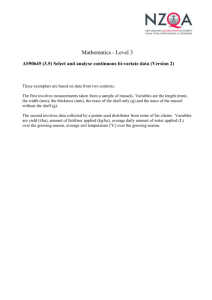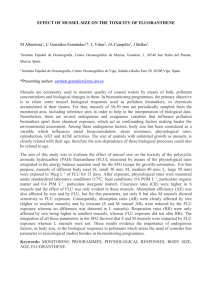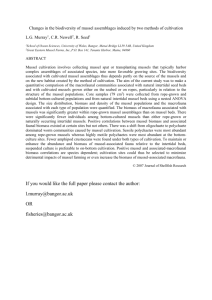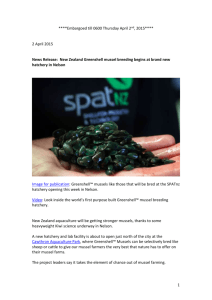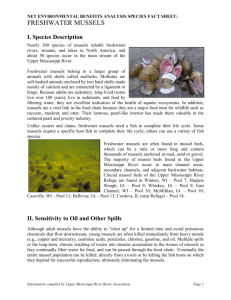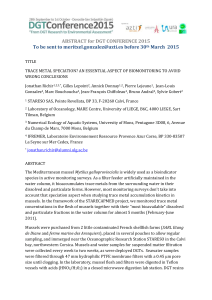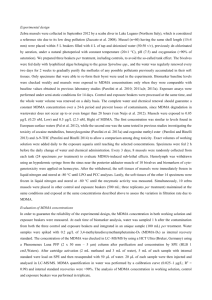Supplementary material - Springer Static Content Server
advertisement
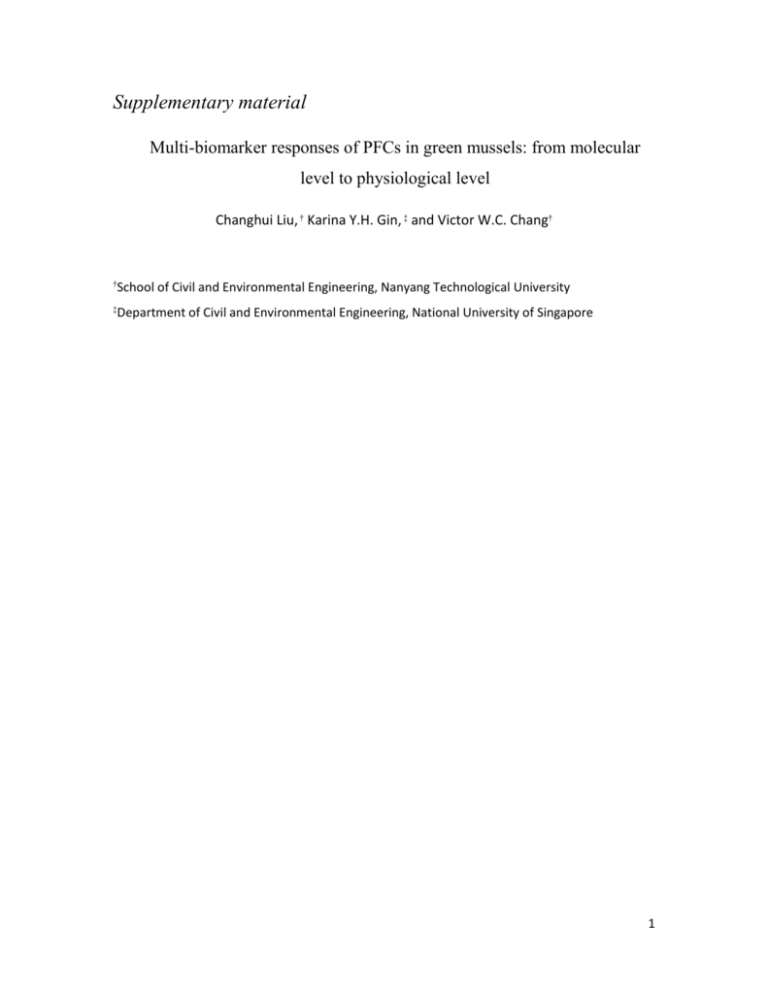
Supplementary material Multi-biomarker responses of PFCs in green mussels: from molecular level to physiological level Changhui Liu, † Karina Y.H. Gin, ‡ and Victor W.C. Chang† † School of Civil and Environmental Engineering, Nanyang Technological University ‡ Department of Civil and Environmental Engineering, National University of Singapore 1 Methods Mussel acclimation and maintenance In current study, green mussels, Perna viridis, were selected as the target organism because in a previous study, they were proved to have great potential to bioaccumulate PFCs (Liu et al., 2011). In addition, bivalves, especially mussels have been conventionally used as the sentinel organisms for environmental monitoring, as they are sessile and filter-feeding organism that are in direct contact with contaminated compartments, and can provide a time integrated indication of contamination with measurable cellular and physiological responses (Izquierdo et al., 2003). Mussels were purchased from a local fish farm in Singapore (Lim Chu Kang). Only mussels with a shell length of 60-65 mm were selected for the experiment. Mussels were acclimated to laboratory conditions for one week before the exposure experiment. They were raised in artificial seawater made by mixing sea salts with distilled water. The water was maintained at 25⁰C with salinity at 25ppt. A 12-hr light-dark circle was employed to simulate the diurnal variation of sunlight. Commercial marine micro algae (Reed Mariculture Inc. Campbell, CA) were used to feed the mussels every two days 2 hours before the water change. The exposure experiment Five exposure concentrations were applied: 0.1, 1, 10, 100 and 1000 μg/L. The typical PFCs level in ocean water is approximately a few hundred pg per liter (Cai et al., 2012). These compounds have been detected in oceanic water up to 17.8 -192 ng/L in Asian (Hu et al., 2011; Wang et al., 2012). In current study, the exposure concentration range was selected to include concentrations that were environmentally relevant, and also concentrations that were high enough to elicit distinguishable effects in order to elucidate possible modes of action (Arukwe and Mortensen, 2011). 50 liter polypropylene (PP) tanks were used as test chambers in which 40 mussels were raised. For each exposure concentration, duplicate tanks were used. Another duplicate tank was engaged as the control, where no PFCs were present. All tanks were cleaned and refilled every two days, where water sample and mussel sample were also taken for concentration analysis using LC MS/MS (Liu et al., 2011). Background concentrations in mussels and waters have also been analyzed and were found to be at non- detectable levels. Sample preparation Mussel haemolymph was extracted from the anterior adductor muscle with a hypodermic syringe filled with physiological saline. The physiological saline was prepared by mixing HEPES 4.77 g, 2 NaCl 25.48 g, MgSO4 13.06 g, KCl 0.75 g, CaCl2 1.47 g and distilled water to 1 L. The pH was adjusted to be 7.36-7.5 with NaOH. The haemolymph mixture was then transferred to a microcentrifuge tube. Mussel soft body was cut into pieces and homogenized in 100 nM phosphate buffer (pH7.4, KCl 100 mM, EDTA 1 mM) using a tissue homogenizer. Protease inhibitor (Complete Protease Inhibitor, Roche) was also added. The homogenate was then centrifuged at 500xg for 20 min at 4°C. The supernatant was subsequently transferred into clean tubes and centrifuged again at 2000xg for 30 min at 4°C. Finally the supernatant was ultracentrifuged at 100000xg for 90 min at 4°C. The final supernatant was transferred to clean tubes in ice before analysis. The protein content was quantified using the Bradford protein assay using Bovine Serum Albumin as the standard (Bio-Rad). Biomarker analysis Catalyse (CAT) activity. CAT activity was measured in the cytosolic extract of whole soft tissues as described elsewhere (Binelli et al., 2009). The reaction was initiated by adding 20 μl of diluted H2O2 to microplate wells with 20 μl of cytosolic extract, 30 μl of methanol and 100 μl phosphate buffers. After 20 min incubation at 25°C, 30 μl KOH and 30 μl of chromogen were added subsequently. After 10 min incubation, 10 μl of KIO4 was added and the plate was incubated for 5 min. The absorbance was reading at 540 nm. The results of CAT activity were expressed in terms of micromole formaldehyde per milligram protein per min. 7-ethoxy resorufin O-deethylase (EROD) activity. EROD activity was measured as described elsewhere (Jönsson et al., 2002), where mussel gill arches were excised and placed in ice cold HEPES-Cortland buffer (pH 7.7). The tip pieces were isolated by a cut above the septum of the gill filaments which resulted in tips pieces about 2 mm long. For each mussel, 2 mm pieces were selected and groups of ten pieces were placed in microcentrifuge tubes. 0.5 ml of reaction buffer was added and pre-incubated for 10 min. The reaction buffer consisted of 7-ethoxyresorufin (1 μM) and dicumarol (10 μM) in HEPES-Cortland buffer. The reaction buffer was then removed and replaced repeatedly with 0.7 ml fresh reaction buffer with an incubation period of 10 min and 30 min at 25°C. Triplicates of 0.2 ml aliquots were transferred from each tube to a fluorescent 96 well microplate. Resorufin standards (0.5-250 nM) were also included on each plate in triplicates of 0.2 ml aliquots. The standards were diluted from stock solution (10 mM in methanol) using reaction buffer. The fluorescence was determined using a microplate reader at 544 (ex) and 590 (em) nm. The EROD activity was expressed as pmole of resorufin per mg protein per min. 3 Comet Assay. The Comet assay was performed using the Comet Assay Kit from Cellbiolabs, Inc. The haemolymph suspension was centrifuged at 700xg for 2 min and the supernatant was discarded. The cells were washed and resuspended in ice cold PBS at 1x105 cells/ml. The cell sample was then mixed with pre-liquified agrose at 1:10 (v/v). 75μl of the mixture was transferred immediately onto microscope slides. The slides were prepared in triplicate for each cell sample. The slides were then transferred to 4°C in the dark for 15 min and maintained horizontally. After gelation, the slides were immersed in ice cold lysis buffer and in ice cold alkaline solution each for 30 min at 4°C in the dark. Electrophoresis was performed in alkaline solution for 30 min at 1 volt/cm, 300 mA. After electrophoresis, the slides were first washed twice in ice cold DI water and then immersed in 70% ethanol for 5 min. 100 μl of Vista Green DNA dye was applied to each slide and incubated at room temperature for 15 min before the slides were observed under epifluorescence microscopy (200x). A total of 500 cells were scored for each sample and the captured images were analyzed using CometScore 1.5 (TriTrek) Neutral red retention time (NRRT). Haemolymph was extracted as described in “Sample preparation”. 40 μl of the haemolymph mixture was transferred to a poly-l-lysine coated microscope slide and the slides were immediately placed into a light-proof humidity chamber for 15 min for the hemocytes to settle down. After the incubation, excess haemolymph mixture was removed. 40 μl of neutral red working solution was then added to the slides and examined under a light microscope using an x40 objective every 10 min. When not examined, the slides were kept in the humidity chamber. The neutral red working solution was prepared by mixing neutral red stock solution (20mg/ml in DMSO) with physiological saline at 1:200 (v/v). The time at which the best estimate of 50% of the cells showing stressed was recorded as the retention time. Filtration rate. The filtration rate was determined as described elsewhere (Okay and Karacik, 2008) with modifications. The filtration rate was based on the filtration of microalgae by individual mussels in static systems. At the end of the exposure period, mussels were placed separately in 3L plastic tanks with magnetic stirrers. The tanks were filled with 2L of artificial seawater and 200 μl dense algae were added to each tank. The concentration of algae in each tank was determined by a spectrophotometer (750 nm) at 10 min intervals for a total time period of 120 min. The filtration rate of mussels was evaluated as: V dC Q C dt (1) 4 Q (ln C1 ln C2 ) V t1 t2 (2) where V = volume of the tank and Q = filtration rate in L/hour Relative condition factor (RCF). The weight and shell length of individual mussel were measured at day 0 and 7 of the exposure experiment. The relative condition factor (RCF) was calculated as an indicator of the general well-being of the mussel: RCF W aLb (3) where W is total body weight (in g) and L is shell length (in cm). The parameters a and b were determined from the length-weight relationship (W = aLb) of mussels at day 0 and was used as a constant factor for all individual mussel. The RCF is calculated as the ratio of measured body weight and calculated body weight. This procedure allows the comparison of the condition of each concentration group as well as the control group before and after the exposure. Reference Arukwe, A., Mortensen, A.S., 2011. Lipid peroxidation and oxidative stress responses of salmon fed a diet containing perfluorooctane sulfonic- or perfluorooctane carboxylic acids. Comparative Biochemistry and Physiology C-Toxicology & Pharmacology 154, 288-295. Binelli, A., Parolini, M., Cogni, D., Pedriali, A., Provini, A., 2009. A multi-biomarker assessment of the impact of the antibacterial trimethoprim on the non-target organism Zebra mussel (Dreissena polymorpha). Comparative Biochemistry and Physiology C-Toxicology & Pharmacology 150, 329-336. Cai, M., Zhao, Z., Yin, Z., Ahrens, L., Huang, P., Yang, H., He, J., Sturm, R., Ebinghaus, R., Xie, Z., 2012. Occurrence of perfluoroalkyl compounds in surface waters from the North Pacific to the Arctic Ocean. Environmental Science and Technology 46, 661-668. Hu, J., Yu, J., Tanaka, S., Fujii, S., 2011. Perfluorooctane Sulfonate (PFOS) and Perfluorooctanoic Acid (PFOA) in Water Environment of Singapore. Water, Air, & Soil Pollution 216, 179-191. Izquierdo, J.I., Machado, G., Ayllon, F., d'Amico, V.L., Bala, L.O., Vallarino, E., Elias, R., Garcia-Vazquez, E., 2003. Assessing pollution in coastal ecosystems: a preliminary survey using the micronucleus test in the mussel Mytilus edulis. Ecotoxicol. Environ. Saf. 55, 24-29. Jönsson, E.M., Brandt, I., Brunström, B., 2002. Gill filament-based EROD assay for monitoring waterborne dioxin-like pollutants in fish. Environmental Science and Technology 36, 3340-3344. Liu, C.H., Gin, K.Y.H., Chang, V.W.C., Goh, B.P.L., Reinhard, M., 2011. Novel Perspectives on the Bioaccumulation of PFCs - the Concentration Dependency. Environ. Sci.Technol. 45, 9758-9764. Okay, O.S., Karacik, B., 2008. Bioconcentration and phototoxicity of selected PAHs to marine mussel Mytilus galloprovincialis. Journal of Environmental Science and Health Part a-Toxic/Hazardous Substances & Environmental Engineering 43, 1234-1242. 5 Wang, T., Khim, J.S., Chen, C., Naile, J.E., Lu, Y., Kannan, K., Park, J., Luo, W., Jiao, W., Hu, W., Giesy, J.P., 2012. Perfluorinated compounds in surface waters from Northern China: Comparison to level of industrialization. Environment International 42, 37-46. Table S1 Measured exposure concentration corresponding to nominal concentration. Nominal conc. (μg/L) Control 0.1 1 10 100 1000 PFOS nd 0.12 ± 0.03 1.1 ± 0.1 9.6 ± 0.5 106 ± 10 968 ± 86 PFOA nd 0.08 ± 0.01 1.2 ± 0.05 11.4 ± 0.6 99 ± 8 1120 ± 46 Values represent the mean ± standard error (n=12). Table S2 PFCs concentration after 7 days exposure (μg/Kg) Exposure conc. (μg/L) Control 0.1 1 10 100 1000 PFOS nd 13±0.4 124 ± 5 1092±37 3464±25 4186±34 PFOA nd 0.7 ± 0.1 6.5 ± 0.3 58±8 151±12 202±14 Values represent the mean ± standard error (n=10). 6
